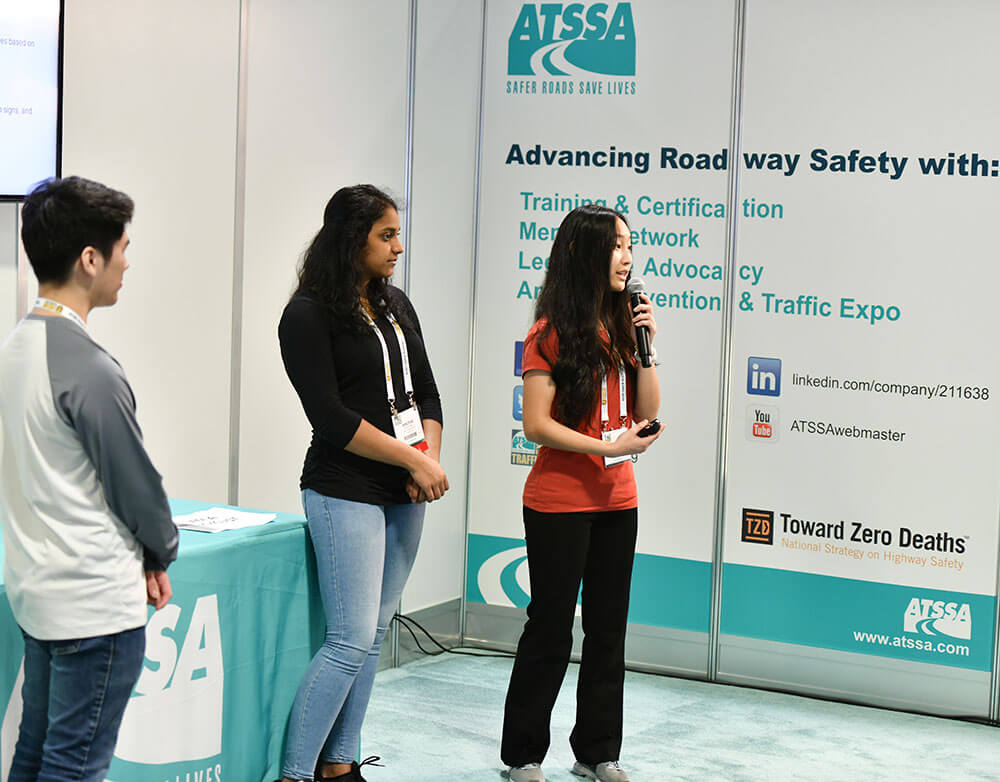
Traffic is welcome on the show floor of the American Traffic Safety Services Association’s 49th Annual Convention and Traffic Expo at the Tampa Convention Center.
Nearly 3,500 roadway safety professionals and transportation officials hit the road to attend the American Traffic Safety Services Association’s (ATSSA) 49th Annual Convention and Traffic Expo at the Tampa Convention Center, Feb. 8–12. The education program included sessions on roadway safety, and the show floor was jammed with new traffic safety solutions and state-of-the-art roadway safety vehicles.
Along with concurrent sessions such as “Advantages of Digital Printing for Traffic Signs” and off-site ATSSA training courses that counted toward industry certification, one of the event’s major educational offerings was the Traffic Control Device (TCD) Challenge for Students, a design competition promoting innovative devices that improve operations and safety.
Now in its third year, the TCD Challenge — a joint partnership between ATSSA and the Transportation Research Board (TRB), a division of the National Research Council of the United States — connects problems that traffic industry professionals face with solutions developed by students across the U.S. These students are studying transportation fields that include such areas as human factors and technology. The TCD Challenge, Brian Watson, director of new programs at ATSSA told Convene, gives students who have great ideas the opportunity “just to get them out there.”
Traffic Jam Sessions
Watson said that because the TCD Challenge is presented as student responses to an industry-wide challenge, the contest has also provided a chance for ATSSA members to engage the transportation community at large.
The TCD Challenge topic for the coming year is decided at ATSSA’s Circle of Innovation event at the annual convention, where in-person Department of Transportation (DOT) reps from across the country discuss safety issues that they haven’t been able to solve and meet with traffic control device manufacturers, suppliers, and distributors whose products aim to address those issues.
This year’s TCD Challenge topic took the concerns DOT reps voiced into account, along with pressing safety challenges cited by respondents to a post-event survey that Watson sent out to 500 to 600 DOT professionals from around the country. One of the top concerns of last year’s Circle of Innovation gathering was how to improve safety for pedestrians and cyclists at signalized intersections. “Over the last few years, pedestrian and cyclist fatalities and accidents have gone up consistently,” Watson said. Choosing that as this year’s TCD Challenge, he said, “was our way of addressing that problem.”
Rubber Meets the Road

Brian Watson
Once a topic is finalized, ATSSA announces the TCD Challenge by reaching out to students using a listing that it has developed over the past three years and contacting university transportation institutes. And through its joint partnership with TRB, ATSSA also leverages its nationwide lists of professors and academics, along with university representatives working on their own research who are part of TRB. “We kind of tap into some of those listings and just get it sent out as many ways as possible — through word of mouth, through an email blast, and through committee outreach as well,” Watson said.
The student challenge took place at Washington, D.C.’s Walter E. Washington Convention Center this past January during the 2019 TRB Annual Meeting, where student teams gave five-minute “Shark Tank”–style idea pitches to judges and a larger audience.
Judges included members of TRB’s traffic control device committee, made up of private enterprises and public officials. Watson said that steps are taken to ensure that there is no conflict of interest in the competition, meaning that there can’t be judges from those colleges and universities that have students competing.
In addition to students competing for the top three prizes, the TRB event gave them valuable exposure. “What we [tell] our students when they come out,” Watson said, is “if this is an industry that you’re interested in, these are people that could be potential employers or potential purchasers of your technology.”
Based on their performance during the pitch presentation at the TRB Annual Meeting, 13 student teams were narrowed down to three winning teams, who then had the option to attend the ATSSA annual convention the following month.
ATSSA covered event registration for up to two members of each winning team, and travel expenses for one member of each team. Each team could dis- play posters for its concepts in a joint exhibit booth on the trade-show floor, and present its traffic control devices at a “Traffic Talk” — informal, 30-minute sessions on the show floor.
Full Speed Ahead
The winning teams earned cash prizes and received a plaque during the ATSSA convention’s Opening General Session. This year, a team from the University of Missouri took first place for its concept, “Vision- Based Pedestrian Indicator Light for Signalized Intersections.” “Flashing Yellow Arrows” was the innovative idea that earned a team from Oregon State University second place, and third place went to an Auburn (Alabama) High School and Newport (Washington) High School team for “Application of RFID at Signalized Intersections in School Zones.” This was the first year that a high-school team submitted a project — and it ended up among the winners.
“It was really neat, novel approach that was really geared towards the students themselves,” Watson said of the high-school team. The idea involved installing RFID tags on student IDs; roadside units at traffic lights would then alert vehicles that there was a student pedestrian at the crosswalk.
The teams will also be featured in an upcoming article in ATSSA’s industry magazine, The Signal, as well as in a hometown press release for each team, although that is not a given. As many are minors, that requires adult permission.
While Watson said that there is no mechanism in place to get venture funding for the students’ ideas, discussions between the students and professionals in the traffic industry are still ongoing.
“I know that there have been a lot of great conversations that they’ve had with our members and with our president,” Watson said.
They’ve been offered “words of encouragement” and advice on potential ways to tweak the product so that it conforms to the Manual on Uniform Traffic Control Devices. In other words, they are being given the right signals to success- fully arrive at their destination.

Students present their concepts for the 2019 TCD Challenge on traffic control devices for pedestrian and cyclist safety at intersections.
Performance Standards
For the 2019 TCD Challenge on traffic control devices for pedestrian and cyclist safety at intersections, students’ proposals were judged based on the following criteria, according to ATSSA’s Brian Watson: How well the solution answers the question. Watson said that the idea or device has to first “address the problem statement.”
- How easy it is to understand. “Is this something that you need an advanced mathematics degree to understand,” Watson said, “or is this something that people who are installing these devices, people that have boots on the ground, can understand?”
- How it follows the standards. Student presentations need to follow guidelines from the Manual on Uniform Traffic Control Devices for Streets and Highways (MUTCD) — which is “kind of the traffic control device Bible,” Watson said. “Everything needs to be a certain way, certain colors need to be used for signage and pavement marking, certain shapes for signs.”
- How feasible it is to implement. This includes the cost of installation, and whether more work needs to be done on the students’ devices to conform to the MUTCD standards. “We can’t go in and for every traffic light, install a $100,000 piece of equipment,” Watson said, “because the local municipalities can’t afford this. There are a lot of intricate details that go into this.”
Jasmine Zhu is an associate editor at Convene.
